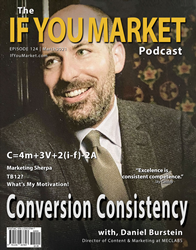

The numbers vary, but the average email open rate stands around 15% to 25%.(1) That means up to 85% of leads (and thus conversions) never have a chance because they are never seen by potential customers. Smart marketers know that conversion consistency is the key to more open rates, and this is achieved by learning about the customer and using that customer learning to fuel what the marketing department is doing. The end result is better performance, i.e., conversions. As Sky Cassidy, host of the podcast If You Market They Will Come, explains, “Some marketers have these flashes of brilliance but they’re not consistent with it, they don’t have a patented, repeatable methodology. Consistency wins.”
Daniel Burstein, senior director of Content & Marketing at MarketingSherpa and MECLABS Institute, oversees all content and marketing coming from the MarketingExperiments and MarketingSherpa brands while helping to shape the marketing direction for MECLABS Institute. He discussed lead conversion and the important of consistency in episode 124#: Conversion Consistency, with Daniel Burstein of the If You Market They Will Come podcast hosted by Cassidy and JOTO PR Disruptors CEO and Chief Evangelist Karla Jo Helms.
Marketing Technology News:Iterate.ai Releases Interplay 6.0; the AI-Fueled Low-Code Platform Accelerates Application…
“If you’re only doing one thing, it should be to understand the motivation of your customer. Too many marketers aren’t grounded in some foundational basics, such as putting themselves in the customer’s shoes, which is why their efforts lack consistency.”
4 Components of an Effective Value Proposition
Burstein explains that MECLABS defines a value proposition as “The answer to the question ‘If I am your ideal prospect, why should I buy from you rather than any of your competitors?’” An effective value proposition is made up of four components:
- Appeal—How much do I desire this offer?
- Exclusivity–Where else can I get this offer?
- Credibility–Can I trust your claims?
- Clarity–What are you actually offering?
Expanding on the idea of how to improve conversions, Burstein details MECLABS methodology to increase conversion summarized by the equation: C=4m + 3V = 2(i-f) – 2A. The “C” stands for conversion, and the “M” is for motivation. “The No. 1 thing you want to do is tap into the motivation of the customer,” says Burstein. “You can’t change their motivation; you have to understand their motivation.” Every customer touchpoint is an opportunity to learn about the customer.
The “V” represents the value proposition, which must have appeal in the marketplace, offer something that no one else has, provide a product or service that delivers and clearly communicate all of this to the customer.
The final components of the equation deal with the negative aspects that marketers want to remove for customers—friction and anxiety. The “I” equals incentive, which Burstein describes as the most used and abused tactic in sales. The “F” stands for friction. The goal is to achieve a balance between the two. For instance, the less friction a marketer creates, the more potential customers will come down the funnel, but many of those leads may wash out. However, highly motivated people will be happy to deal with a higher level of friction, making them more valuable.
Finally, “A” is for anxiety, another negative element, that marketers want to decrease. This may mean a concern a potential customer has about requested information. For instance, maybe marketing asks only for an email in the beginning and not a phone number to help reduce any anxiety about how the potential customer may be contacted. “It’s what sales does in the sales process to reduce sales anxiety,” Burstein says.
Marketing Technology News: Syntax Unveils Lineup Of Four Key Events In April And May 2021
5 Tips to Increase Your Conversion Rate
- Understand your audience: What is most important to them? Where are they making the biggest investments? How can marketing help them achieve those goals and get a better ROI from those investments?
2. Measure the effectiveness: Start by internally ranking your potential value propositions. Then conduct testing like pay-per-click ad testing or A/B email testing. Then see which approach is ready for external use.
3. Remove friction: Friction comes in many forms—unclear or weak content, unanswered questions, a website that isn’t informative or easy to use, or even a lack of trust. Marketers need to put themselves in the customer’s shoes to identify and then handle these points of friction.
4. Add a clear call to action: You understand the customer’s motivation. You’ve tested the options. You’ve removed the friction. But if you haven’t provided a clear and compelling way for them to reach out and contact the business, you won’t get the responses you want.
5. Know when to change: Change is hard. Start by creating a value proposition for why change is necessary, even if it’s a small step. Try testing the new approach and documenting the results or launch a pilot project to build trust.
While Burstein clarifies that the equation’s numbers show the importance of each element in the equation, he advises marketers, “If you’re only doing one thing, it should be to understand the motivation of your customer.” Helms concludes, “Too many marketers aren’t grounded in some foundational basics,” such as putting themselves in the customer’s shoes, which is why their efforts lack consistency.




Comments are closed.